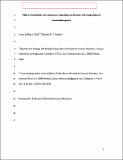Por favor, use este identificador para citar o enlazar a este item:
http://hdl.handle.net/10261/128634COMPARTIR / EXPORTAR:
 SHARE SHARE
 CORE
BASE CORE
BASE
|
|
| Visualizar otros formatos: MARC | Dublin Core | RDF | ORE | MODS | METS | DIDL | DATACITE | |

| Título: | Effects of metabolic rate and sperm competition on the fatty-acid composition of mammalian sperm |
Autor: | Delbarco-Trillo, Javier CSIC ORCID; Roldán, Eduardo R. S. CSIC ORCID | Palabras clave: | Mass-specific metabolic rate Polyunsaturated fatty acids Sperm competition Sperm membrane Lipid peroxidation |
Fecha de publicación: | 20-nov-2013 | Editor: | Wiley-Blackwell European Society of Evolutionary Biology |
Citación: | Journal of Evolutionary Biology 27(1): 55-62 (2014) | Resumen: | The sperm membrane is a key structure affecting sperm function and thus reproductive success. Spermatozoa are highly specialized and differentiated cells that undergo a long series of processes in the male and female reproductive tracts until they reach the site of fertilization. During this transit, the sperm membrane is prone to damage such as lipid peroxidation. The characteristics and performance of the sperm membrane are strongly determined by the fatty-acid composition of membrane phospholipids. Polyunsaturated fatty-acids (PUFAs) are the most prone to lipid peroxidation. Lipid peroxidation and other types of oxidative damage increase with higher metabolism and with higher levels of sperm competition due to the increased ATP production to fuel higher sperm velocities. Consequently, we hypothesized that, in order to avoid oxidative damage, and the ensuing impairment of sperm function, sperm cells exhibit a negative relationship between PUFA content and mass-specific metabolic rate (MSMR). We also hypothesized that higher sperm competition leads to a reduction in the proportion of sperm PUFAs. We performed a comparative study in mammals and found that high MSMR and high levels of sperm competition both promote a decrease in the proportion of PUFAs that are more prone to lipid peroxidation. The negative relationship between MSMR and these PUFAs in sperm cells is surprising, because a positive relationship is found in all other cell types so far investigated. Our results support the idea that the effects of MSMR and sperm competition on sperm function can operate at very different levels. © 2013 European Society For Evolutionary Biology. | URI: | http://hdl.handle.net/10261/128634 | DOI: | 10.1111/jeb.12275 | Identificadores: | doi: 10.1111/jeb.12275 issn: 1010-061X e-issn: 1420-9101 |
| Aparece en las colecciones: | (MNCN) Artículos |
Ficheros en este ítem:
| Fichero | Descripción | Tamaño | Formato | |
|---|---|---|---|---|
| JEvolBiol 27(1) 55-62 (2014) POSTPRINT.pdf | 694,9 kB | Adobe PDF |  Visualizar/Abrir |
CORE Recommender
SCOPUSTM
Citations
25
checked on 22-abr-2024
WEB OF SCIENCETM
Citations
25
checked on 25-feb-2024
Page view(s)
220
checked on 23-abr-2024
Download(s)
226
checked on 23-abr-2024
Google ScholarTM
Check
Altmetric
Altmetric
Este item está licenciado bajo una Licencia Creative Commons

